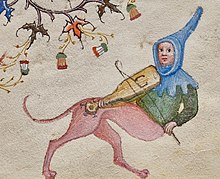
A bestiary is a compendium of beasts. Originating in the ancient world, bestiaries were made popular in the Middle Ages in illustrated volumes that described various animals and even rocks. The natural history and illustration of each beast was usually accompanied by a moral lesson. This reflected the belief that the world itself was the Word of God and that every living thing had its own special meaning. For example, the pelican, which was believed to tear open its breast to bring its young to life with its own blood, was a living representation of Jesus. Thus the bestiary is also a reference to the symbolic language of animals in Western Christian art and literature.

In architecture, and specifically Gothic architecture, a gargoyle is a carved or formed grotesque with a spout designed to convey water from a roof and away from the side of a building, thereby preventing it from running down masonry walls and eroding the mortar between. Architects often used multiple gargoyles on a building to divide the flow of rainwater off the roof to minimize potential damage from rainstorms. A trough is cut in the back of the gargoyle and rainwater typically exits through the open mouth. Gargoyles are usually elongated fantastical animals because their length determines how far water is directed from the wall. When Gothic flying buttresses were used, aqueducts were sometimes cut into the buttress to divert water over the aisle walls.
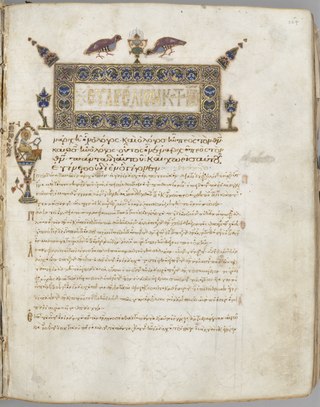
An illuminated manuscript is a formally prepared document where the text is decorated with flourishes such as borders and miniature illustrations. Often used in the Roman Catholic Church for prayers and liturgical books such as psalters and courtly literature, the practice continued into secular texts from the 13th century onward and typically include proclamations, enrolled bills, laws, charters, inventories, and deeds.

The medieval art of the Western world covers a vast scope of time and place, with over 1000 years of art in Europe, and at certain periods in Western Asia and Northern Africa. It includes major art movements and periods, national and regional art, genres, revivals, the artists' crafts, and the artists themselves.

Since at least the 18th century, grotesque has come to be used as a general adjective for the strange, mysterious, magnificent, fantastic, hideous, ugly, incongruous, unpleasant, or disgusting, and thus is often used to describe weird shapes and distorted forms such as Halloween masks. In art, performance, and literature, however, grotesque may also refer to something that simultaneously invokes an audience feeling of uncomfortable bizarreness as well as sympathetic pity.

Books of hours are Christian prayer books, which were used to pray the canonical hours. The use of a book of hours was especially popular in the Middle Ages, and as a result, they are the most common type of surviving medieval illuminated manuscript. Like every manuscript, each manuscript book of hours is unique in one way or another, but most contain a similar collection of texts, prayers and psalms, often with appropriate decorations, for Christian devotion. Illumination or decoration is minimal in many examples, often restricted to decorated capital letters at the start of psalms and other prayers, but books made for wealthy patrons may be extremely lavish, with full-page miniatures. These illustrations would combine picturesque scenes of country life with sacred images.
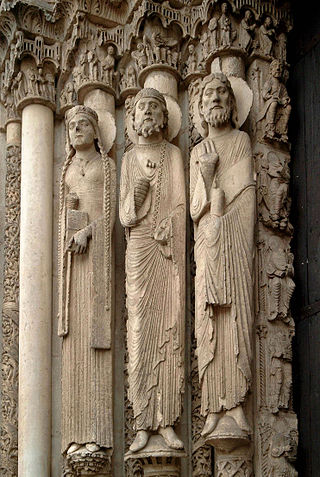
Gothic art was a style of medieval art that developed in Northern France out of Romanesque art in the 12th century AD, led by the concurrent development of Gothic architecture. It spread to all of Western Europe, and much of Northern, Southern and Central Europe, never quite effacing more classical styles in Italy. In the late 14th century, the sophisticated court style of International Gothic developed, which continued to evolve until the late 15th century. In many areas, especially Germany, Late Gothic art continued well into the 16th century, before being subsumed into Renaissance art. Primary media in the Gothic period included sculpture, panel painting, stained glass, fresco and illuminated manuscripts. The easily recognizable shifts in architecture from Romanesque to Gothic, and Gothic to Renaissance styles, are typically used to define the periods in art in all media, although in many ways figurative art developed at a different pace.
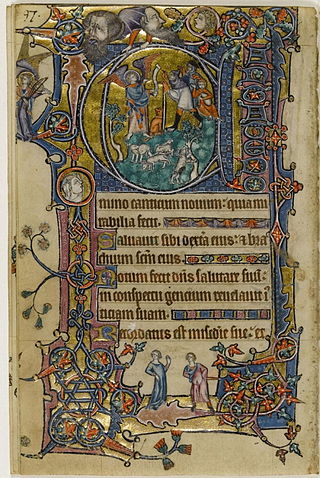
The Macclesfield Psalter is a lavishly illuminated manuscript probably produced c. 1320–30 in East Anglia. The psalter, or book of Psalms, contains 252 beautifully illustrated pages and is named after its most recent owner, the Earl of Macclesfield.

The Luttrell Psalter is an illuminated psalter commissioned by Sir Geoffrey Luttrell (1276–1345), lord of the manor of Irnham in Lincolnshire, written and illustrated on parchment circa 1320–1340 in England by anonymous scribes and artists.

In a written or published work, an initial is a letter at the beginning of a word, a chapter, or a paragraph that is larger than the rest of the text. The word is ultimately derived from the Latin initiālis, which means of the beginning. An initial is often several lines in height, and, in older books or manuscripts, may take the form of an inhabited or historiated initial. Certain important initials, such as the Beatus initial, or B, of Beatus vir... at the opening of Psalm 1 at the start of a vulgate Latin. These specific initials in an illuminated manuscript were also called initia.

The British Library is a research library in London that is the national library of the United Kingdom. It is one of the largest libraries in the world. It is estimated to contain between 170 and 200 million items from many countries. As a legal deposit library, the British Library receives copies of all books produced in the United Kingdom and Ireland, including a significant proportion of overseas titles distributed in the United Kingdom. The Library is a non-departmental public body sponsored by the Department for Culture, Media and Sport.

In the visual arts, interlace is a decorative element found in medieval art. In interlace, bands or portions of other motifs are looped, braided, and knotted in complex geometric patterns, often to fill a space. Interlacing is common in the Migration period art of Northern Europe, in the early medieval Insular art of Britain and Ireland, and Norse art of the Early Middle Ages, and in Islamic art.

The Psalter World Map or the Map Psalter is a small mappa mundi from the 13th century, now in the British Library, found in a psalter. No other records of psalters found from the Middle Ages have a mappa mundi.

The Howard Psalter and Hours is a 14th-century illuminated prayerbook. It includes a liturgical Psalter with canticles and litany, the Office of the Dead, a calendar of East Anglian origin and an incomplete Hours of the Passion. It was produced between 1310 and 1320. It is written in Latin in a Gothic script in two columns per page. There are 115 extant folios which measure 360 by 235 mm. The text block occupies an area of 250 by 166 mm. It is bound together with the De Lisle Psalter, a contemporary psalter.

The Isabella Psalter, also called the Psalter of Queen Isabella or the Psalter of Isabella of England, is a 14th-century volume containing the Book of Psalms, named for Isabella of France, who is herself depicted in it; it was likely a gift upon her betrothal or marriage. The illuminated manuscript is also notable for its bestiary.

The Taymouth Hours is an illuminated Book of Hours produced in England in about 1325–35. It is named after Taymouth Castle where it was kept after being acquired by an Earl of Breadalbane in the seventeenth or eighteenth century. The manuscript's shelf mark originates from its previous owner, Henry Yates Thompson, who owned an extensive collection of illuminated medieval manuscripts which he sold or donated posthumously to the British Library. The Taymouth Hours is now held by the British Library Department of Manuscripts in the Yates Thompson collection.

The Gorleston Psalter is a 14th-century manuscript notable for containing early music instruction and for its humorous marginalia. It is named for the town of Gorleston in Norfolk.
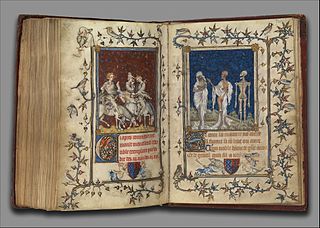
The Psalter of Bonne de Luxembourg is a small 14th-century illuminated manuscript in tempera, grisaille, ink and gold leaf on vellum. It is held in the collection of The Cloisters, New York, where it is usually on display.
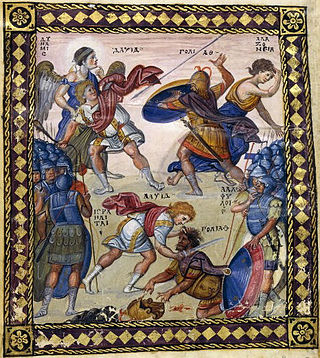
Byzantine illuminated manuscripts were produced across the Byzantine Empire, some in monasteries but others in imperial or commercial workshops. Religious images or icons were made in Byzantine art in many different media: mosaics, paintings, small statues and illuminated manuscripts. Monasteries produced many of the illuminated manuscripts devoted to religious works using the illustrations to highlight specific parts of text, a saints' martyrdom for example, while others were used for devotional purposes similar to icons. These religious manuscripts were most commissioned by patrons and were used for private worship but also gifted to churches to be used in services.

Gothic book illustration, or gothic illumination, originated in France and England around 1160/70, while Romanesque forms remained dominant in Germany until around 1300. Throughout the Gothic period, France remained the leading artistic nation, influencing the stylistic developments in book illustration. During the transition from the late Gothic period to the Renaissance, book illustration lost its status as one of the most important artistic genres in the second half of the 15th century, due to the widespread adoption of printing.
